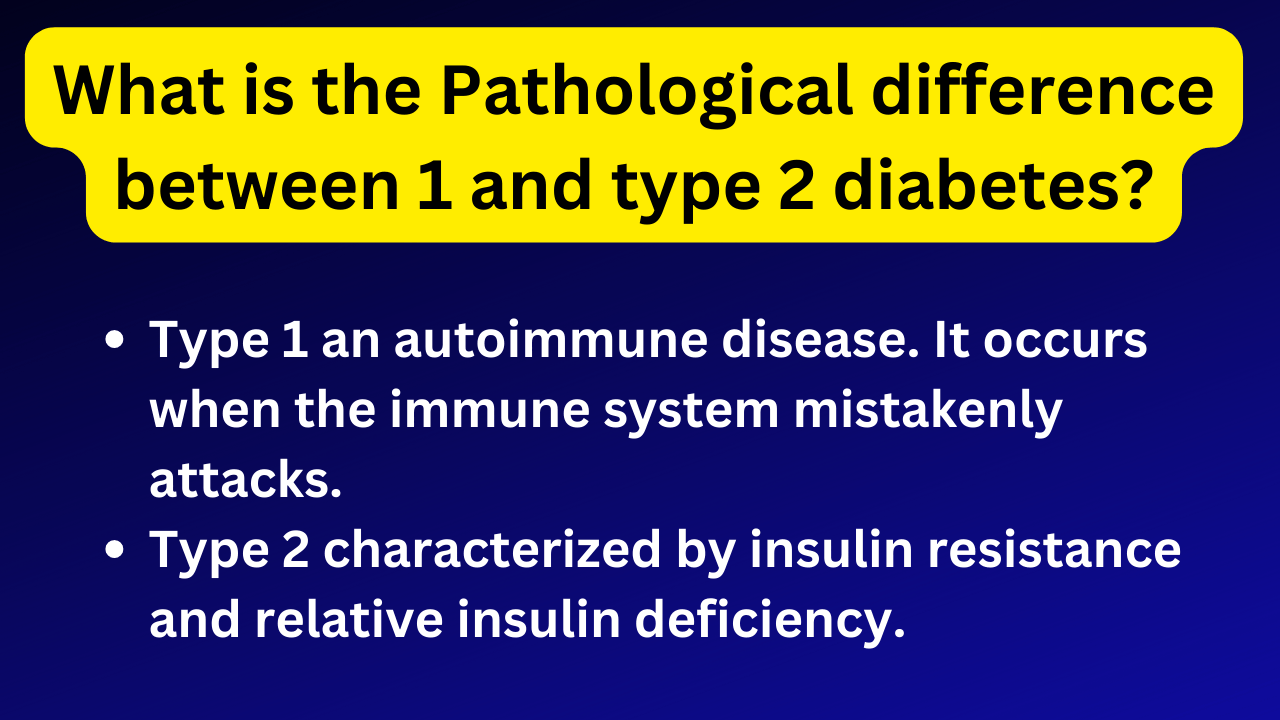Pathological difference between type 1 and 2 diabetes
The pathological difference between 1 and type 2 diabetes is that both are chronic metabolic disorders that affect the way the body regulates blood sugar (glucose). While they share the common feature of high blood sugar levels, they have different underlying pathological mechanisms.
-
Type 1 diabetes
It is also known as insulin-dependent diabetes or juvenile-onset diabetes, is an autoimmune disease. It occurs when the immune system mistakenly attacks and destroys the insulin-producing beta cells in the pancreas.
-
Type 2 diabetes
It is also called non-insulin-dependent diabetes or adult-onset diabetes, is characterized by insulin resistance and relative insulin deficiency.
Note: type 1 involves autoimmune destruction of pancreatic beta cells, resulting in absolute insulin deficiency, while type 2 is primarily characterized by insulin resistance and relative insulin deficienc.
Major differences between type 1 and type 2 diabetes
Type 1 and type 2 diabetes are two distinct forms of diabetes with significant differences in terms of their causes, age of onset, treatment approaches, and risk factors. Here are the SIX major differences between type 1 and type 2 diabetes:
1. Underlying cause:
– Type 1 diabetes: It is an autoimmune disease where the immune system mistakenly attacks and destroys the insulin-producing beta cells in the pancreas. This results in an absolute deficiency of insulin.
– Type 2 diabetes: It is primarily caused by a combination of insulin resistance (cells becoming less responsive to insulin) and relative insulin deficiency. Insulin resistance is often associated with obesity, genetic factors, and lifestyle factors.
2. Age of onset:
– Type 1 diabetes: It is commonly diagnosed in children, adolescents, and young adults, although it can occur at any age.
– Type 2 diabetes: It usually develops in adults over the age of 40. However, due to increasing obesity rates and sedentary lifestyles, type 2 diabetes is increasingly being diagnosed in younger individuals, including children and teenagers.
3. Insulin requirement:
– Type 1 diabetes: People with type 1 diabetes have an absolute deficiency of insulin and require lifelong insulin therapy through multiple daily injections or insulin pump.
– Type 2 diabetes: Initially, people with type 2 diabetes may not require insulin therapy. They may manage their condition with lifestyle changes (diet and exercise) and oral medications. However, as the disease progresses, some individuals with type 2 diabetes may eventually need insulin or other injectable medications to maintain blood sugar control.
4. Body weight and obesity:
– Type 1 diabetes: There is no direct association between type 1 diabetes and obesity. People with type 1 diabetes can be of normal weight, underweight, or overweight.
– Type 2 diabetes: Obesity is a significant risk factor for type 2 diabetes. Excess weight, particularly abdominal obesity, contributes to insulin resistance and the development of type 2 diabetes.
5. Risk factors:
– Type 1 diabetes: Family history and genetic predisposition are the primary risk factors for type 1 diabetes. Environmental triggers, such as certain viral infections, may also play a role.
– Type 2 diabetes: The risk factors for type 2 diabetes include obesity, sedentary lifestyle, poor diet (high in processed foods and sugar), family history of diabetes, advancing age, and certain ethnic backgrounds (such as African, Hispanic, Asian, and Native American descent).
6. Prevalence:
– Type 1 diabetes: It accounts for about 5-10% of all diabetes cases.
– Type 2 diabetes: It is the most common form of diabetes, accounting for approximately 90-95% of all diabetes cases globally.
What is the similarities between type 1 and type 2 diabetes?
Type 1 and type 2 diabetes have distinct causes and pathophysiological mechanisms, but there are certain similarities. Here are some similarities between them.
- Elevated blood sugar levels: Both types of diabetes are characterized by high blood sugar levels (hyperglycemia).
- Similar symptoms: Increased thirst, frequent urination, unexplained weight loss, fatigue, and blurred vision are common symptoms that can occur in both types.
- Chronic condition: Both type 1 and type 2 diabetes are chronic conditions that require ongoing management and treatment.
Type 1 vs 2 diabetes
Type 1 Diabetes
Type 2 Diabetes symptoms
Features: Most patients are obeseClinical Symptoms: Blood insulin Levels are normal
Pathology: No Insulitis, Amyloid Deposition in pancreatic cells.
Pathogenesis: No HLA linkage
Genetic: Insulin Resistance
